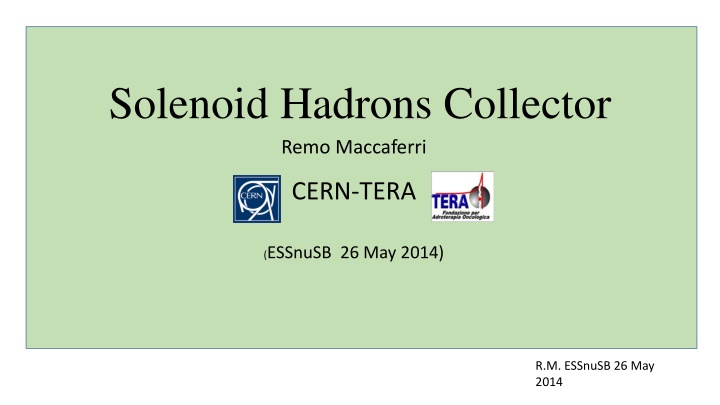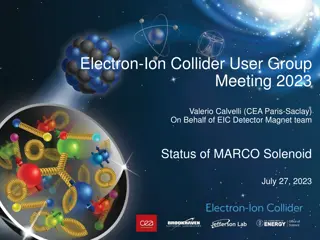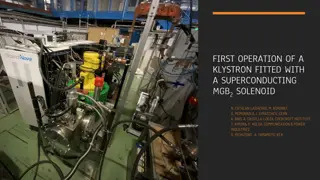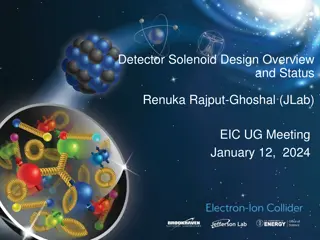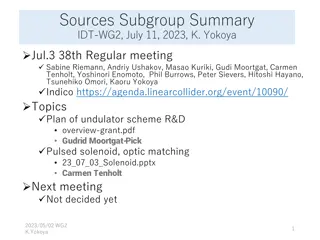Feasibility Study of Using Solenoid as Focusing Device in High-Energy Physics
Investigating the possibility of using a solenoid as a focusing device instead of a magnetic horn in high-energy physics. Special emphasis on the preliminary design of a superconducting solenoid, with details on bore radius determination, field behavior, and maximum field strength achievable. Collaboration with TERA team members for feasibility study included.
Download Presentation

Please find below an Image/Link to download the presentation.
The content on the website is provided AS IS for your information and personal use only. It may not be sold, licensed, or shared on other websites without obtaining consent from the author.If you encounter any issues during the download, it is possible that the publisher has removed the file from their server.
You are allowed to download the files provided on this website for personal or commercial use, subject to the condition that they are used lawfully. All files are the property of their respective owners.
The content on the website is provided AS IS for your information and personal use only. It may not be sold, licensed, or shared on other websites without obtaining consent from the author.
E N D
Presentation Transcript
Solenoid Hadrons Collector Remo Maccaferri CERN-TERA (ESSnuSB 26 May 2014) R.M. ESSnuSB 26 May 2014
Topics -Introduction -Magnetic Horn (focusing Principle) -Solenoid (focusing Principle) -Superconducting solenoid preliminary Design -Conclusion R.M. ESSnuSB 26 May 2014
Introduction: possibility to use a solenoid as +/ focusing device instead of a magnetic horn. As special superconducting magnets specialist, I accepted to carry-on a preliminary feasibility study of such device, with a graceful cooperation of some members of the TERA team(V. Rizzoglio & D. Bergesio) I was asked by some of you, to investigate the R.M. ESSnuSB 26 May 2014
+ B Magnetic Horn toroidal field focusing effect R.M. ESSnuSB 26 May 2014
B Solenoid (focusing Principle) +/- Vz Beam axis v vr F 0.5 m. R.M. ESSnuSB 26 May 2014
Superconducting solenoid preliminary Design To define the bore radius of the solenoid, one need to know the angular and momentum distribution of the +, (Nikolaos Vassilopoulos) The acceptance should be 400 mRad for a pion with 700 MeV/c. With these requirements using commercial superconducting wires, we choose a reasonable compromise for the free bore dimension and for the maximum field which can be safely produced. R.M. ESSnuSB 26 May 2014
GeV/c This figure shows a combined plot of pion momentum production distribution and the solenoid magnetic acceptance with an inner free air bore of 150 mm radius and Bz=16 Tesla. R.M. ESSnuSB 26 May 2014
With this geometry, 16 Tesla is the maximum field which can be produced with a superconducting Nb3Sn Rutherford shaped cable 10x2 mm, able to sustain the 13 kA current needed (Short sample at 18T, 15kA, and 4.7 K). Solenoid cross section R.M. ESSnuSB 26 May 2014
Solenoid Field Behaviour R.M. ESSnuSB 26 May 2014
Preliminary conclusion project. More calculations must be done: optics, radiation deposition & damages, forces, mechanical & thermal constraints, quench protection & cryogenics, power supplies, etc. (need someone to do). This study has to be considered as a first approach of this A similar study limited to the optics calculations has been already done by Harold B. Kirk(Brookhaven 2006) where he demonstrate the advantages of using a solenoid instead a magnetic horn. R.M. ESSnuSB 26 May 2014
Conclusion As my personal feeling from the engineer point of view, it seems possible (thanks to the enormous progress of superconductivity) building this magnet as a solution to obtain a neutrino s facility without major s modifications of the ESS complex. THANK YOU R.M. ESSnuSB 26 May 2014
